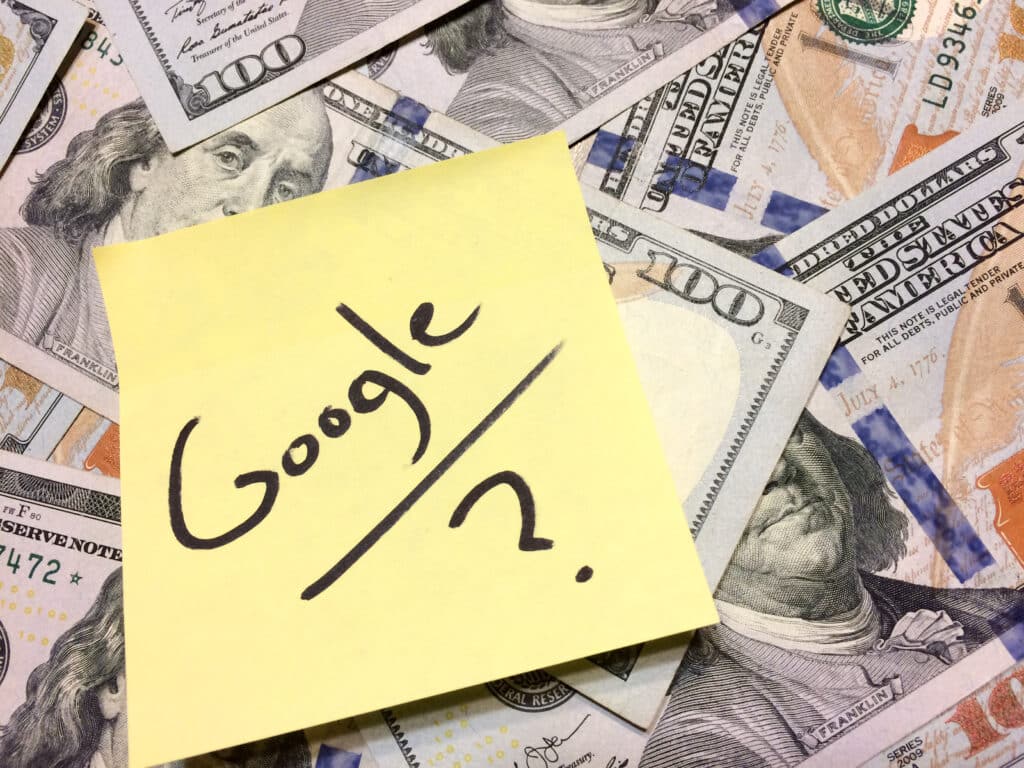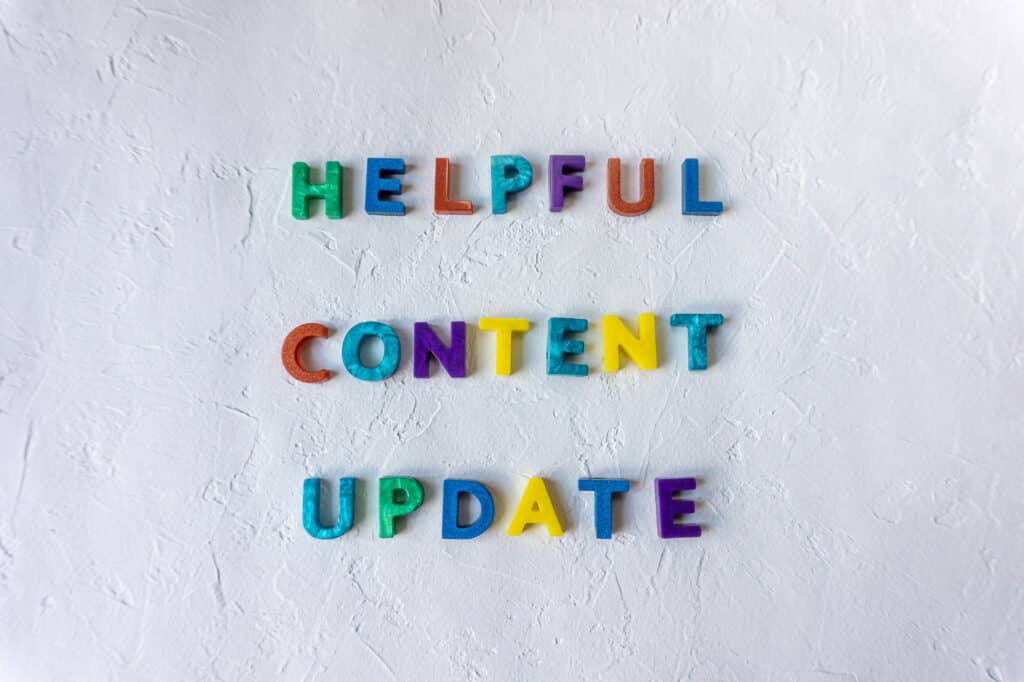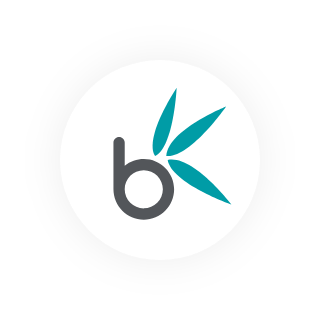Rank-Ageddon? How Google’s Helpful Content Update Keeps Destroying Websites, and How We Avoid It
Contents
- Google’s content dilemma
- The helpful content update
- Protecting yourself from helpful content
- How Helpful Content has impacted our approach to SEO
Surviving Google’s Helpful Content Update
While only officially declared a monopoly (in US court) in 2024, Google has long enjoyed near-universal dominance of the organic search market. For the many industries that depend entirely on Google traffic, from online retail to web journalists and even SEO agencies (gulp), it’s easy to feel like a tiny insect clinging to the back of some giant hoofed mammal, your entire life dependent on this being so towering that it can barely fathom your existence. When relying on the vagaries of the Google algorithm to deliver visitors to your site, sudden changes can wipe out a business overnight.
Starting in late 2022, Google rolled out its “Helpful Content” updates, designed (in theory) to reward good content and punish bad. The results have been controversial, with websites slipping into obscurity overnight, careers ended, and a groundswell of discontent from creators. The reasons for these changes are complex, and Google’s response to the outcry belies a difficult possibility; that many of these results are accidental.
In order to remain afloat in this turbulent sea it’s crucial to understand why these algorithm updates were made, why so many sites have run afoul, and the best processes to follow to protect your own website, or those of your clients.
Google’s content dilemma

Despite all the evidence to the contrary, Google wants people to enjoy using its search engine. While its long-term market dominance attests to some success in this area, there are whispers of discontent. From Reddit posts to tech prognosticators, there is a general agreement that Google search is worse than it used to be. Whether looking for travel tips or buying an airfryer, the SERP is often bloated, confusing, and unhelpful.
This (and a few other, somewhat less consumer-friendly goals) were the likely issues driving the Helpful Content updates:
Issue #1 – Low-quality traditional SEO content
Google has long had a complicated relationship with the SEO industry, a continuing back-and-forth of innovation and response that has seen an inarguable improvement in the quality of web content, at least for a while.
Early SEO techniques relied on tactics like hiding crucial keywords on a page and repeating them hundreds of times, whereas modern approaches focus on creating in-depth content—though often still centred around a single keyword. If that keyword is “mattresses” and it’s a page selling mattresses, then that’s great. But if it’s a page around, say, the date a new series of a TV show will air, and the page is 1,000 words that eventually mentions that there isn’t actually a date yet… not so great.
A glut of content that isn’t necessarily what people are looking for has therefore taken up residence on a range of big keywords, making it harder than ever to find information online. Many online news sites are particularly guilty of this, and much of what’s posted online is broadly built out of existing content, rewritten and zhuzhed up in an attempt to entice the Google algorithm.
Bluntly, all of this is a problem for Google, who want to reward high-quality content and punish content that is unoriginal, unhelpful, and not written with readers in mind.
Issue #2 – AI slop

And if you thought that was bad!
AI has truly changed the world over the last couple of years, by making several companies extremely wealthy, using the energy of a mid-size country, and increasing usage of the word “meticulously” in academic papers by 137%. While AI has been added to just about every tech product on the market, alongside hoovers, toothbrushes, and washing machines, the two things it’s best at (and I use the term somewhat loosely) are text and image.
Soon after ChatGPT exploded in late 2022, the implications for the world of online content were clear: this thing could write vaguely accurate, correctly-spelt, not-especially-interesting content — and fast. It could also make images for said content. Sure, the people in those images had melting eyes and an above-average number of fingers, but hey, it was the future!
The Content Team at Bamboo Nine have spent so many hours wading through churned-out AI content that we can normally spot it pretty fast. However, Google’s results are full of AI-created articles and images, little of which actually meet people’s desires. This technology has compounded the existing problems with quality, as those people looking to game the system can now do so at a far bigger scale than before.
Issue #3 – Capitalism
Google’s fundamental goal, like most companies within the healthy, functioning economic model we’ve chosen, is to make as much money as possible. It generates nearly 80% of its revenue from paid advertising and is continually looking for ways to make more of that filthy lucre. When you use Google to search for something and click an organic link, they aren’t making any money. This, potentially, is something they’d like to change.
Google has long incorporated small answer snippets into search results and has recently added wholly AI-generated answers at the top of SERPs, encouraging people to eat rocks, use glue as a pizza ingredient, or jump off bridges. The goal of this is clear: to get people to stay on Google rather than heading to any of the results. Wider changes to the Google algorithm should therefore be considered with this in mind. Google wants to provide users with what they’re looking for within the SERP page itself.
There are also suggestions from some that the decline in the quality of Google’s algorithm is the direct result of some sort of internal power struggle between the forces of good and an invading army of degenerate management consultants (their words). Whatever the truth may be, the top dogs at Google are not running a charity, and their stockholders expect unlimited growth forever, so it’s important to consider that changes to the algorithm may not be quality-oriented.
The helpful content update

First announced in August 2022, Google has undertaken a series of algorithm updates under the “helpful content” umbrella. When announcing these changes, Google spoke about their goals, showing a clear emphasis on writing original content backed up by demonstrable expertise. It also made it clear that having a large volume of low-quality content on a site would harm the rankings of any quality content on the site.
Sounds great, right? Well…
The people most affected
The September 2023 helpful content update is where things really started changing. Many sites found their rankings falling across hundreds of keywords, reducing their traffic to near zero overnight. This predominantly affected blogs, review sites, and news sites, most of whom were relying on organic traffic to generate ad revenue.
Here are just some of the groups affected:
- Travel writers: Site Digtaloft explored the precipitous decline in traffic experienced by many travel websites. Eight in ten of the 670 sites they surveyed showed a drop in traffic, with nearly a third of sites experiencing a 90% drop. Writer James Brockbank is quick to point out that these sites and their content are not spam, nor are they perceptively low quality. The list of sites that grew the most is also quite damning, with recognised brands Time Out and Lonely Planet gaining the highest amounts of organic traffic.
- News sites: Amsive showed the impact of the September 2023 update on news publishers, with 73% of publishers surveyed reporting that their Google Discover traffic had dropped to 0. There were also complaints from publishers about massive declines in ad revenue, about their content no longer appearing in Top Stories, and about stolen content outranking their original pages. When gaming and media publisher Gamurs Group laid off 30 staff in September 2024, they specifically cited the helpful content update as the reason.
- Other independent sites: An interesting article from HouseFresh, a blog dedicated to air purifiers and dehumidifiers (no, really) lays out how low-quality articles from known names consistently outrank better content on Google. In many cases, morally upstanding private equity companies bulk buy these established names and rework their content model around affiliate links, which can have a clear impact on objectivity (as seen at once dominant tech website CNET). There are even examples of popular websites asking for payment to be included in a “Best Product” page. HouseFresh personally lost 91% of their traffic in helpful content updates, seriously affecting their income and ability to continue.
What’s the big deal?

There are numerous factors that could lead to a blog being punished, and it’s worth noting that quality is a recurring thread. Many of those sites demoted, such as the ones run by the Gamurs group, were serving up thin SEO content. For the end user, these sites being demoted could be seen as a positive. At the same time, sites that are rife with ads, including full-screen pop-ups, are also being punished, which, again, is unlikely to cause readers to shed any tears.
And yet within the feedback from sites, including what’s shown above, it’s abundantly clear that these updates are not consistently punishing low-quality content like they claim they are, and have in fact impacted the sorts of content that people would actively benefit from finding. It’s pretty inarguable that things are fixed, either. Look at tech site The Verge, for example, which ranked on Google with a spoof “Best Printers of 2024” article, making fun of Google and the kinds of pages it ranks.
When researching this article, the most useful pages I found were never at the top of rankings, and in many cases, the pages that ranked were referencing and rewriting the original articles I was looking for. To me, this is not unusual. When assessing the effectiveness of the helpful content update, ask yourself this: have I noticed an improvement in Google results over the last two years?
Google, notoriously tight-lipped and prone to lying though they may be, have even tentatively admitted that there have been unintended consequences to the helpful content updates.
Google’s response
In October 2024 Google reached out to a number of small creators, inviting them to visit the Google HQ as part of a Creator Summit. At this point in time, a year on from the 2023 update that changed everything, many of these site owners had already drastically wound down their businesses thanks to dwindling revenues.
Those invited, such as Mike Hardaker of Mountain Weekly News, and Morgan Mcbride of Charleston Crafted, reported that while there were several senior members of the Google team in attendance, and clear admissions that quality content was being penalised, there were no clear answers as to why this had happened, no clear journey to recovery, and lashings of PR gobbledegook.
That Google held this event at all is a positive sign, perhaps, for small creators, but in Mcbride’s words, “If you were hit by HCU & depend on Google, MOVE ON.”. In her post-summit Twitter thread, she also spoke of how the Google employees in attendance either seemed to deny the problem existed or be completely clueless about how to fix it.
Which I guess leads us to…
The worst-case scenario

The worst-case scenario for sites that rely entirely on traffic driven through organic search is complete oblivion, suddenly and for no clear reason. If this update was merely punishing those making Google worse, that might ding the SEO industry for a while, but ultimately it would be a positive for users.
But this just isn’t the case.
Many of the sites ranking highly for informational searches are of a truly dire quality, stuffed with advertorial content written by algorithms. Meanwhile, Google is going all in on AI to scrape, amalgamate, and occasionally hallucinate the content of others within its results pages.
When looking at these contrasting desires, a push for original expert content smashing against an embrace of AI misinformation, a helpful content update that rewards shell publications filled with adverts, and a team who seem confused about how their own algorithm even works, it can be hard to grasp at a wider intent.
Perhaps, though, the scale and power of Google make it hard to recognise what could at its core just be simple incompetence. Competing interests, vampiric moneymen, and a morass of data sellotaped together, spitting out results that are just about competent enough to stop users from switching to Bing. Maybe there’s nothing at the centre of this? Maybe there is no plan?
So what should you do?
Protecting yourself from helpful content
Firstly, if you are a small publication relying on organic search to drive readership, and funded purely by adverts, it might be time to reconsider your approach. Whatever your business, though, our team recommends a three-pronged approach to avoiding the worst of the latest Google updates:
Step #1 – Clean up your past

Every piece of content on your site (or at least, every indexed page) will be considered within your rankings, so any skeletons in your closet can really impact the performance of your new content. This means it’s time to go through every page on your site, from the About Us page to the oldest blog, either updating it to fit the latest quality metrics or removing it entirely. Here are the questions you should be asking when assessing the value of a page:
- Is the page well written?
- If the page is a blog, does it have an author with a full bio?
- Is the writer of the article verifiable as an expert in the field?
- Are all the pictures and links relevant, good-quality, and working?
- Is the page original, or is it broadly a regurgitation of others’ content?
- Who is the audience for the page, and does the content meet their needs?
- If the page is built around a keyword, will it satisfy the intent of those searching that keyword?
- Does the page align with the website, and business, as a whole?
- Is the content thorough, honest, and up to date?
It’s worth looking through Google’s own documentation again and taking the time to thoroughly look through your entire site with this in mind. Anything that doesn’t meet these high standards, whether posted a week ago or a decade ago, needs to be fixed or deleted.
Step #2 – Write relevant, high-quality content
When you make new content for your site, uniqueness and quality must come first. The content you write should be relevant to the theme and topic of your website or brand, and be written or overseen by someone with demonstrable authority in the subject (especially in medicine or finance, so-called YMYL content). It should feature information that can’t be found elsewhere, new images whenever possible, and should be written to a reasonable length.
While keyword optimisation is still valuable for demonstrating the relevance of pages across your site, directly targeting informational keywords is less important than ever, with Google looking to answer these queries within the results page, and penalising sites for making this sort of content.
Step #3 – Diversify your approach

SEO isn’t dead (I promise!), but it’s changed, and should now be considered as part of a wider digital marketing arsenal. The goal of SEO should be to create a clear, useful, optimised website, and to fill it with genuinely high-quality content. If your site is selling products and services, this can go hand in hand with paid ads on Google, alongside organic and paid social media.
If you’re looking to sustain as an independent publisher it’s probably time to consider diversifying. This could be moving towards subscription models like Medium, Substack or Patreon, or making content that can gain traction through other avenues, like YouTube videos or podcasts. If you’re able to establish multiple avenues of revenue and traffic, then your risk will be less severe should one of them shift suddenly.
How Helpful Content has impacted our approach to SEO
Our team is always adjusting our approach around changes in the Google algorithm. When Google started prioritising helpful content, we implemented a new approach for reviewing and updating existing content for our clients. After crawling and listing every page on a website, members of our SEO team give pages a quick overview, making notes on any changes that would be needed to make the page “helpful”, and making suggestions on how to proceed. Through this, we make informed decisions around altering, rewriting, or deleting content.
At the same time, we rebuilt our approach to creating new content, establishing clear audiences for each client, and planning truly engaging content aimed at them rather than targeting informational keywords. This content is designed to be shared on social accounts and linked within sales pages, while also indicating high levels of quality to Google. We work with clients to establish members of their teams as experts, including getting them to share work they contributed to on their personal LinkedIn pages. This multipronged approach has allowed us to better meet Google’s aims while providing clear value to our clients.
We’ve also worked to better integrate our previously separate teams, offering a joined-up full-service model to clients. In this model, content is planned with Social performance and PR in mind, our tech team optimises the websites they build around the latest SEO principles, and specialist landing pages are built just for PPC. All of this is constructed upon higher levels of client collaboration than ever before, ensuring all aspects of our campaigns are strategically aligned to deliver the results they are looking for.
Benefit from a smarter approach to SEO

If you’re looking for comprehensive digital marketing, our team has a decade of experience across B2B and E-Commerce in a huge range of industries. When it comes to SEO and content, we prioritise original, high-quality work throughout, keeping you safe from the uncertainties of organic rankings. Speak to a member of our team to find out more.


